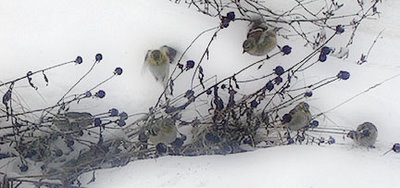
Snow is not the little digital camera's forte. It has a "snow" setting" but still, as always, I had to mess with these images quite a bit to try to get them out of the neutral range--they are still too grey. Days like this I miss my old Asahi Pentax Spotmatic--fully manual, easy to get the right exposure. (I still have it, but it needs repairs I can't afford right now--and I'm hooked on the immediacy of the digital.)

Rabbit tracks run right through the print, so not the tracks of sucessfully captured prey I think. Not clear just what happened here--but I suspect that this is the mark of a great horned owl (GHOW).

As I finished taking a few shots I heard a terrible crow ruckus coming from the fields. Blue jays joined in. I started back to see if I could locate them, with owls on my mind. I could see the fuss centred on a bit of the near edge of the cedar bush. As I walked up the object of the harassment flushed and flew off in the direction of the far field. All I saw was big, brown, low-flying and flapping. Could it be that this was the very GHOW that had visited the yard last night?
The blue jays stayed in the cedar bush, and continued to call. The crows, 5 or 6 of them, took off in hot pursuit. The object of their chase apparently landed again beyond the edge of the far field. The winds were brisk--the temperature about -15C, and chasing birds across fields over snow and ice is a mug's game, so I stayed where I was to see if the bird would flush back into view. The fuss continued for a few more minutes, then all together the crows stopped calling and flew off. Had their quarry flown out of their area of concern too low for me to see it--or did the crows figure that they'd made their point, and could now go on with their day?



















